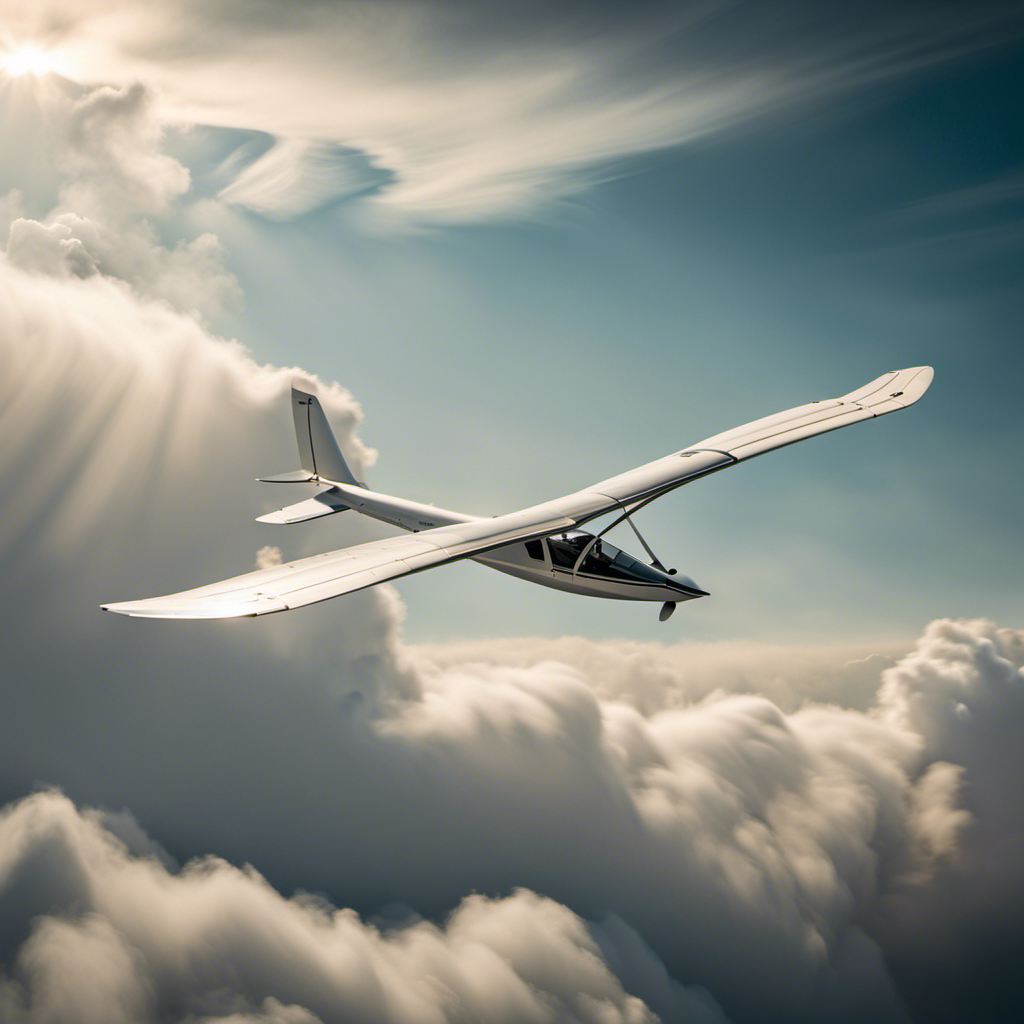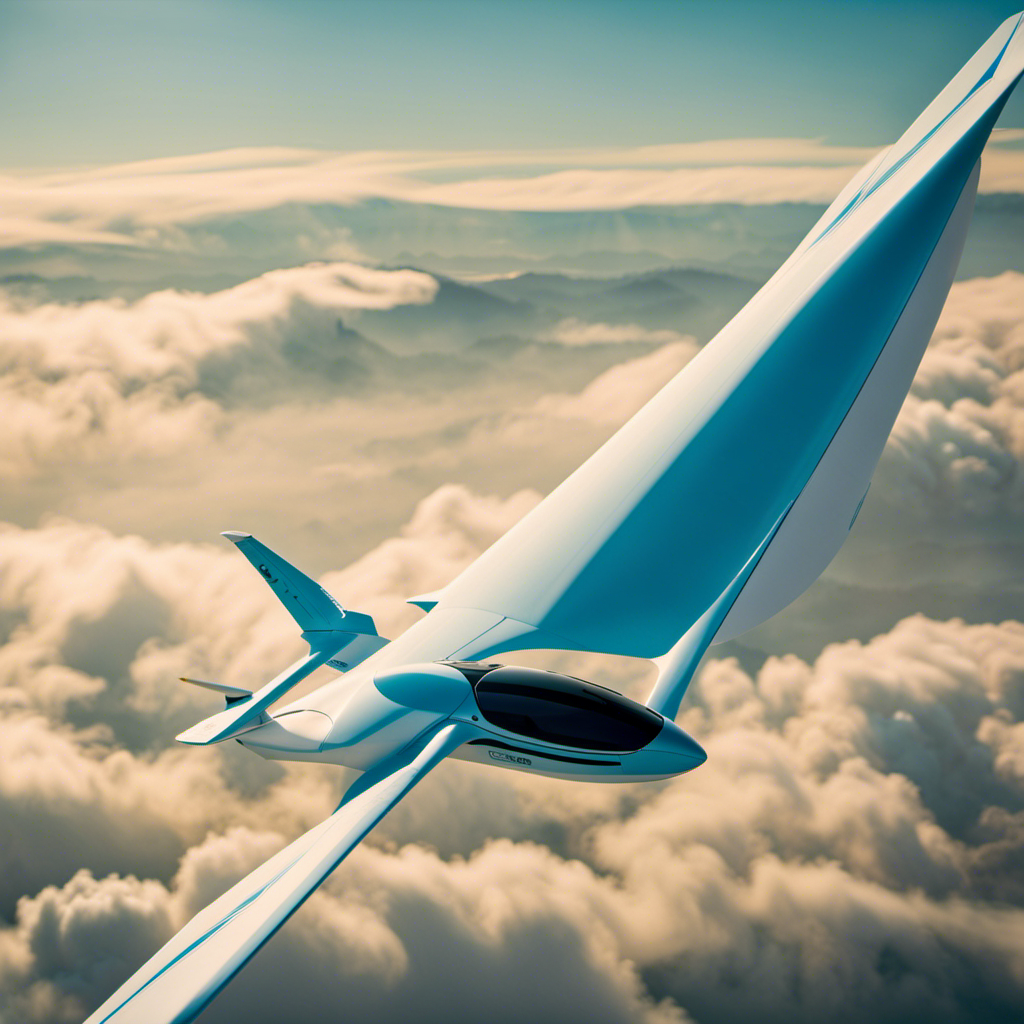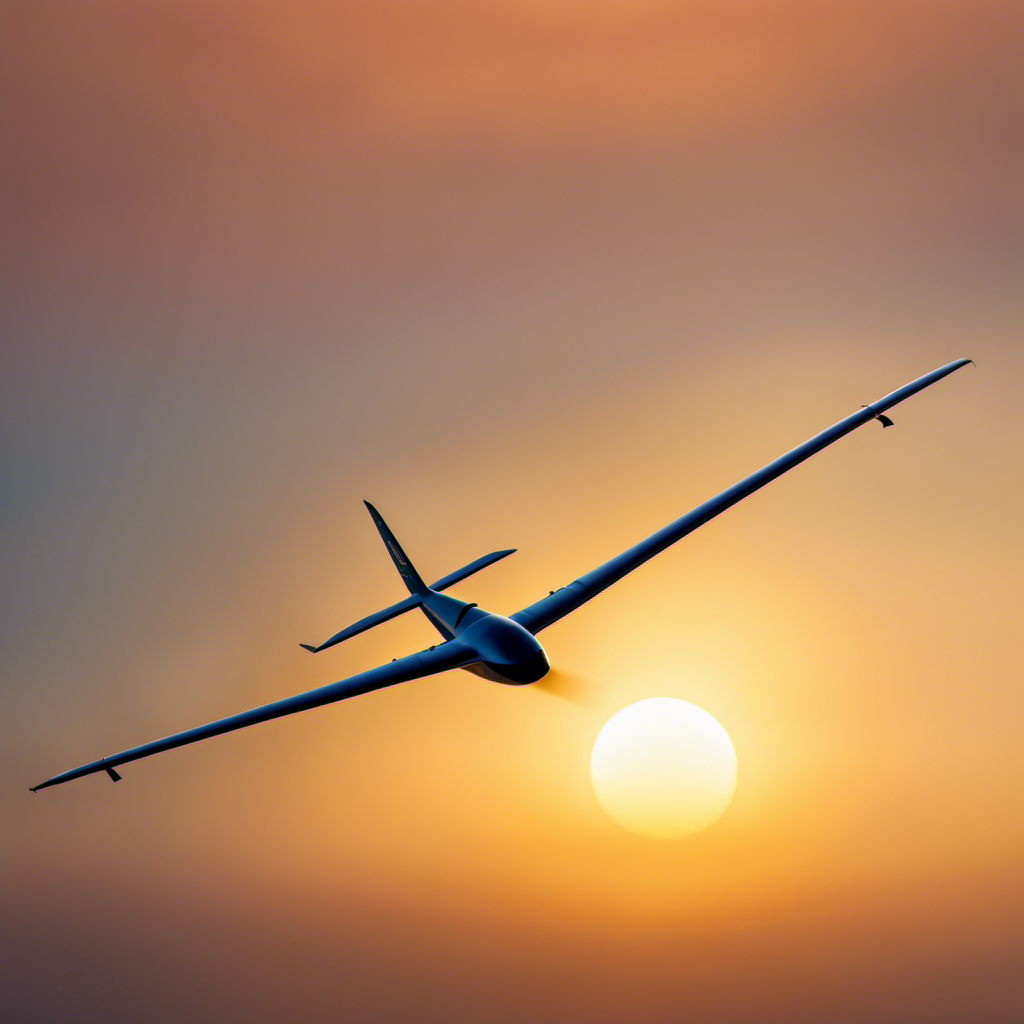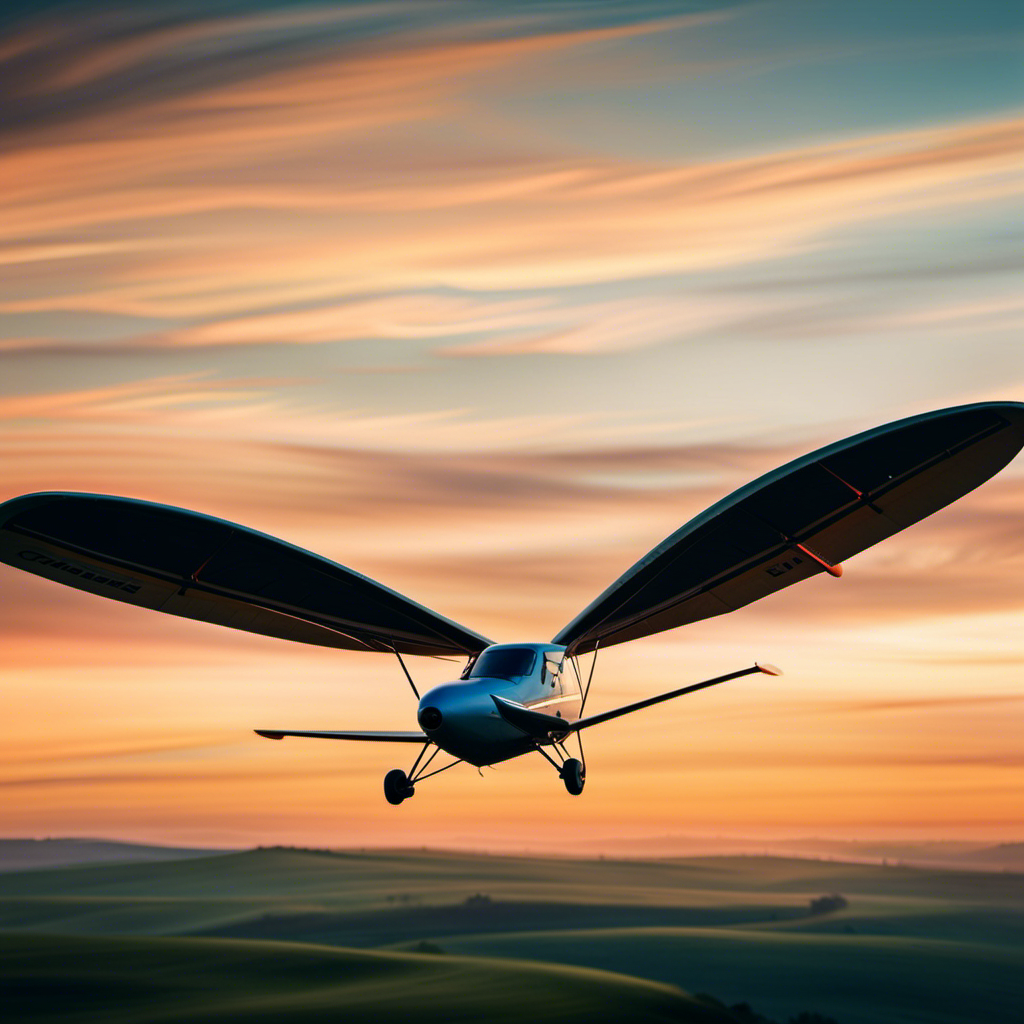I have always been fascinated by the skill of gliding, particularly impressed by the ability of experienced pilots to stay in the air for hours without using an engine.
In this article, we’ll delve into the world of thermals, those invisible pockets of rising air that enable gliders to soar effortlessly through the sky.
From understanding thermals to mastering advanced techniques, we’ll explore the ins and outs of flying in a thermal and the rewards it brings.
Key Takeaways
- Understanding thermals is crucial for staying airborne for extended periods.
- Thermals can be located and entered using visual cues and variometer readings.
- Navigating between thermals requires knowledge of wind patterns and cloud formations.
- Maximizing flight duration and prioritizing safety are important considerations when gliding in thermals.
Understanding Thermals
You’ll need to understand how thermals work and how to identify them while flying in order to successfully navigate and stay aloft. Thermals are columns of rising air created by the sun’s heating of the Earth’s surface. As the ground warms up, it heats the air above it, causing it to rise. This rising air creates an updraft that glider pilots can use to gain altitude. Understanding thermals is crucial for gliding because they are the key to staying airborne for extended periods of time.
To analyze conditions and identify thermals, you must first look for visual cues. Cumulus clouds, which are formed by the rising air in thermals, are a clear indicator of their presence. These clouds appear puffy and have a defined shape, often resembling cauliflower. Additionally, you can observe the behavior of birds. If you notice birds circling or spiraling upwards, it is a strong indication that a thermal is present.
Transition into the subsequent section about pre-flight planning: Once you have a solid understanding of thermals and how to identify them, the next step in maximizing your gliding experience is pre-flight planning.
Pre-flight Planning
Before taking off, make sure to check the weather conditions and plan your flight accordingly. As a pilot, it is crucial to be well-prepared and equipped with the necessary tools and knowledge to ensure a safe and successful flight. Pre-flight planning involves considering the meteorological conditions and utilizing the right pre-flight equipment.
To help you in this process, here is a table summarizing the essential pre-flight equipment and its purpose:
| Pre-flight Equipment | Purpose |
|---|---|
| Weather apps | Access real-time weather data |
| Flight computer | Calculate wind speed and direction |
| Barometer | Measure atmospheric pressure |
| Windsock | Indicate wind direction on ground |
By using these tools, you can gather information about the current weather conditions and make informed decisions about your flight route and timing. It is important to take note of factors such as wind speed, wind direction, and atmospheric pressure, as they greatly affect the presence and strength of thermals.
Now that we have our pre-flight planning covered, let’s move on to the next step: locating thermals. By understanding the characteristics of thermals and observing nature’s indicators, we can effectively navigate the skies and maximize our gliding experience.
Locating Thermals
Now that we know how to plan our flight, let’s explore how to locate thermals for optimal gliding. Thermal detection is a crucial skill for every glider pilot. Thermals are invisible columns of rising air that allow us to gain altitude and extend our flight. To find these thermals, we engage in the art of thermal hunting.
One method of thermal detection is observing visual cues. We look for cumulus clouds, as they often indicate the presence of thermals. These clouds form when warm air rises, condenses, and forms a cloud. Additionally, we keep an eye out for birds, as they are skilled at finding thermals. When we spot a bird circling in a specific area, it’s a good sign that a thermal is present.
Another technique is using a variometer, a device that measures the rate of climb or descent. It provides audio and visual cues to indicate thermals. When the variometer indicates a positive climb rate, we can follow it to locate the thermal.
By combining visual cues and variometer readings, we can effectively detect and locate thermals.
Now that we know how to find them, let’s delve into the next section on entering and staying in a thermal, where we will learn the technique of circling within the thermal to maximize our altitude gain and prolong our flight.
Entering and Staying in a Thermal
Using the technique of circling within the thermal, I can maximize my altitude gain and prolong my flight. Thermal soaring techniques are essential for maintaining altitude in a thermal and making the most of the rising air currents. By flying in a circular pattern within the thermal, I can stay within the core where the lift is strongest. This allows me to climb higher and gain more potential energy.
To emphasize the importance of circling within the thermal, let’s take a look at the following table:
| Benefits of Circling within the Thermal | Techniques |
|---|---|
| Maximizes altitude gain | Spiral climb |
| Prolongs flight duration | Figure-eight pattern |
| Exploits strongest lift | Tight turns |
As I circle within the thermal, I use techniques such as spiral climbs, figure-eight patterns, and tight turns. These maneuvers help me stay within the core of the thermal, where the lift is strongest. By continuously adjusting my bank angle and rate of turn, I can maintain a steady climb and prevent sinking back into the descending air currents.
Transitioning into the subsequent section about navigating between thermals, it is important to maintain a strategic approach to maximize my gliding performance.
Navigating Between Thermals
As I navigate between thermals, I rely on my knowledge of wind patterns and cloud formations to locate the next source of lift. Crosswind techniques become particularly important when flying in mountainous regions, where the terrain can cause unpredictable wind patterns. By understanding how to use crosswinds to my advantage, I can adjust my flight path to maximize lift and stay in the thermal longer.
When thermalling in mountainous regions, I pay close attention to the direction and strength of the wind. I look for signs of wind direction changes, such as variations in cloud formations or the movement of trees and vegetation on the ground. By analyzing these indicators, I can anticipate crosswind components and adjust my turns and bank angles accordingly.
In addition to wind patterns, cloud formations play a crucial role in locating thermals. Cumulus clouds, for example, can indicate the presence of lift. I look for well-developed, cauliflower-shaped clouds with a flat base and a puffy top. These clouds often form above thermals and can serve as a visual guide for the next source of lift.
Maximizing Flight Duration
To increase your flight duration, you need to carefully manage your energy and make efficient use of each thermal you encounter. Maximizing lift and optimizing flight techniques are key to achieving this goal.
When flying in a thermal, it is essential to understand how to position your glider to take maximum advantage of the rising air. This involves flying in a circular pattern within the thermal, constantly adjusting your bank angle and speed to stay within the core. By maintaining a constant turn in the thermal, you can ensure that your glider remains within the strongest lift and avoids sinking air on the edges.
In addition to flying in a tight circle, it is important to actively search for thermals and choose the most promising ones. Look for visual indicators such as cumulus clouds, birds soaring, or dust devils. These can all point to the presence of thermal activity. Once you have found a thermal, focus on staying within it as long as possible. Make small adjustments to your bank angle and speed to maintain the optimal position within the thermal’s core.
Advanced Techniques for Experienced Pilots
Flying cross-country using thermals is an exhilarating challenge that requires advanced techniques and precise navigation. Competing in thermal gliding competitions pushes experienced pilots to their limits as they strive for maximum speed and distance.
When flying in challenging conditions or at high altitudes, it’s crucial to be prepared with the right equipment and to have a thorough understanding of weather patterns and aerodynamics.
Flying cross-country using thermals
Using thermals, pilots can cover long distances while gliding cross-country. Cross country strategies in gliding rely heavily on understanding thermals and weather patterns.
Thermals are columns of rising warm air that glider pilots use to gain altitude and stay airborne. By locating and circling within thermals, pilots can extend their flight time and cover greater distances.
Successful cross-country flights require careful planning, taking into account factors such as wind direction, cloud formations, and the availability of thermals along the intended route. By analyzing weather forecasts and studying the local topography, pilots can identify potential thermal sources and plan their flight accordingly.
Mastering cross-country gliding involves recognizing and exploiting these thermals to stay aloft and progress towards the intended destination. Transitioning from flying cross-country to competing in thermal gliding competitions requires honing these skills even further.
Competing in thermal gliding competitions
Competing in thermal gliding competitions requires honed skills and a deep understanding of weather patterns and how to exploit them. To succeed in these high-stakes events, pilots must develop effective competition strategies and engage in rigorous mental preparation. The table below outlines key aspects of competition strategies and mental preparation for thermal gliding competitions.
| Competition Strategies | Mental Preparation |
|---|---|
| Study previous winning flights | Visualize successful flights |
| Analyze weather forecasts | Practice focused concentration |
| Develop efficient route planning | Manage stress and anxiety |
| Enhance thermalling techniques | Build confidence and self-belief |
Tips for flying in challenging conditions or at high altitudes
When it comes to tackling challenging conditions or flying at high altitudes, pilots must be aware of the potential risks and take necessary precautions.
Flying in windy conditions can be particularly demanding, requiring pilots to employ specific strategies for maintaining altitude. One effective technique is utilizing the crabbing method, where pilots slightly angle the aircraft into the wind to counteract its force. This helps to maintain the desired track and prevent drifting off course.
Additionally, adjusting the airspeed and power settings can aid in maintaining altitude during gusty winds. It is crucial for pilots to continuously monitor and adjust their flight controls to counteract the effects of the wind.
By mastering these strategies, pilots can navigate through windy conditions while maintaining a safe altitude.
In the event of an emergency, knowing and promptly executing the appropriate safety and emergency procedures is vital to ensure the well-being of both the pilot and passengers.
Safety and Emergency Procedures
When it comes to safety and emergency procedures in aviation, there are three key points to consider.
First, recognizing signs of turbulence or dangerous thermal activity is crucial for a pilot to avoid potential risks and navigate the aircraft safely.
Second, having emergency landing techniques in case of unexpected thermal loss is essential for a pilot to be prepared for any unforeseen circumstances.
Lastly, dealing with emergencies and mechanical failures in-flight requires quick thinking and decisive action to ensure the safety of everyone on board.
Recognizing signs of turbulence or dangerous thermal activity
Pay attention to the dark, towering clouds and sudden shifts in wind direction; these are signs of turbulence or dangerous thermal activity that you should recognize while flying in a thermal. Recognizing thermal patterns is crucial to avoid turbulence and ensure a smooth gliding experience.
Look for areas where the air rises, indicated by cumulus clouds forming in a specific pattern. These thermal sources can provide lift and help you gain altitude. However, it’s important to be cautious as thermals can also become unstable and produce turbulent conditions.
Keep a close eye on the sky and trust your instincts when it comes to identifying potential hazards. By staying vigilant and avoiding turbulence, you can maximize your chances of a successful flight.
Now, let’s explore emergency landing techniques in case of unexpected thermal loss.
Emergency landing techniques in case of unexpected thermal loss
If you find yourself in a situation where you experience unexpected thermal loss, it’s important to remember the proper emergency landing techniques. Here are some key steps to keep in mind:
- Maintain control of the aircraft:
- Stay calm and focused, keeping your hands firmly on the controls.
- Adjust the attitude of the aircraft to maintain the best glide speed.
Choose a suitable landing area:
- Look for open fields or flat surfaces without obstacles.
- Consider wind direction and strength to select the optimal landing spot.
Remember, emergency landing techniques are crucial in mitigating the risks associated with thermal loss. By following these steps, you increase your chances of a safe landing.
Now, let’s explore how to deal with emergencies and mechanical failures in-flight.
Dealing with emergencies and mechanical failures in-flight
To effectively handle emergencies and mechanical failures in-flight, you should familiarize yourself with the proper procedures and protocols.
When dealing with bird strikes, it is crucial to stay calm and assess the situation quickly. First, maintain control of the aircraft and communicate with air traffic control to inform them of the incident.
Next, inspect the aircraft for any visible damage and check the engine instruments for any abnormalities. If there is a sudden loss of lift, immediately reduce the aircraft’s angle of attack and increase airspeed to regain control.
It is important to follow the manufacturer’s guidelines for emergency procedures and consult the aircraft’s checklist for specific instructions.
Learning from experienced pilots can provide valuable insights into handling emergencies and mechanical failures, allowing you to enhance your skills and make informed decisions in challenging situations.
Learning from Experienced Pilots
When it comes to learning from experienced pilots, there are various avenues for gaining mentorship and guidance.
Joining glider clubs and communities allows for valuable connections with seasoned pilots who can provide invaluable advice and support.
Attending workshops and training programs specifically designed for advanced thermal flying can further enhance one’s skills and knowledge in this area.
Additionally, sharing experiences and tips with fellow glider pilots fosters a sense of camaraderie and enables the exchange of valuable insights and techniques.
Joining glider clubs and communities for mentorship and guidance
Joining a glider club or community is a great way to connect with experienced pilots who can provide mentorship and guidance. These clubs often have mentorship programs in place, where seasoned pilots offer their expertise to those who are new to the sport. Through these mentorship programs, you can benefit from the knowledge and experience of these pilots, helping you accelerate your learning curve.
Additionally, many glider clubs have online forums where members can ask questions, share experiences, and receive valuable advice. These forums provide a platform for pilots to connect, learn from each other, and stay updated on the latest trends and techniques in gliding.
By joining a glider club or community, you can tap into a wealth of knowledge and resources that will enhance your journey towards mastering the art of gliding.
Transitioning into attending workshops and training programs for advanced thermal flying, you can further refine your skills and deepen your understanding of this exhilarating aspect of gliding.
Attending workshops and training programs for advanced thermal flying
Attending workshops and training programs can help pilots enhance their skills in advanced thermal flying.
These workshops offer numerous benefits, including the opportunity to learn new and advanced techniques from experienced instructors.
Through hands-on exercises and demonstrations, pilots can gain a deeper understanding of how to read thermals, navigate them effectively, and maximize their gliding performance.
Workshops also provide a platform for pilots to ask questions, seek clarification, and receive personalized feedback on their flying techniques.
The interactive nature of these programs allows for a more comprehensive learning experience, ensuring that pilots are equipped with the knowledge and skills necessary to navigate challenging thermal conditions.
Furthermore, attending workshops provides a unique opportunity to connect with other glider pilots, fostering a sense of camaraderie and the chance to share experiences and tips with fellow aviators, improving the overall flying community.
Sharing experiences and tips with fellow glider pilots
Interacting with other glider pilots allows you to exchange experiences and tips to improve your skills. It’s a valuable opportunity to learn from those who have mastered the art of gliding. Here are three key benefits of sharing flight stories and techniques with fellow pilots:
-
Broadening your knowledge: Hearing about different pilot techniques and approaches can expand your understanding of gliding. You may discover new strategies or perspectives that can enhance your own flying abilities.
-
Learning from mistakes: When pilots share their experiences, they often talk about the challenges they’ve faced and the mistakes they’ve made. By learning from these stories, you can avoid making similar errors and increase your chances of success in the air.
-
Building a supportive community: The gliding community is tight-knit and supportive. By engaging with other pilots, you’ll develop connections, make friends, and find a network of individuals who share your passion for flying.
The Thrill and Rewards of Flying in a Thermal
Soaring through the sky in a thermal gives you an exhilarating rush and the ultimate sense of achievement. The joy and freedom of soaring effortlessly with the wind is unparalleled. As a glider pilot, I have learned various techniques for optimizing thermal glides, allowing me to stay aloft for longer periods and cover greater distances. By honing these skills, I have been able to fully experience the thrill and rewards that flying in a thermal has to offer.
One key technique for optimizing thermal glides is centering the thermal core. This involves circling within the rising air to gain altitude. By observing the vario instrument, which displays the rate of climb, I can determine the strongest part of the thermal and adjust my circle accordingly. Additionally, maintaining a steady bank angle while circling helps to maximize lift and minimize drag.
Another technique is reading the sky for visual cues. Clouds, birds, and even the terrain can indicate the presence of a thermal. In my experience, cumulus clouds are a telltale sign of thermal activity. Flying towards these clouds and circling within them can lead to extended periods of soaring.
In order to make my glides in a thermal more efficient, I also pay close attention to my airspeed and altitude. Adjusting the airspeed can help me find the optimal glide ratio, maximizing my forward progress while minimizing sink. Monitoring the altitude is crucial, as it allows me to determine the best time to leave the thermal and continue on my desired path.
By incorporating these techniques into my flying, I have been able to fully embrace the joy and freedom of soaring in a thermal. The sense of accomplishment when successfully riding a thermal and covering great distances is truly unmatched.
Frequently Asked Questions
How long does it take to become proficient at flying in thermals?
It takes time and practice to become proficient at flying in thermals. To spot thermals quickly, look for indicators like birds or rising dust. To stay in a thermal efficiently, use banking turns and adjust your speed accordingly.
What are some common mistakes that pilots make when entering a thermal?
Common mistakes during thermal entry are often due to misjudging the wind’s direction or underestimating the thermal’s strength. It’s like blindly swimming against a strong current or trying to hold onto a tornado.
Are there any specific weather conditions that are more conducive to finding thermals?
Ideal weather conditions for finding thermals include sunny days with high temperatures, low wind speeds, and clear skies. Best practices for thermal flying involve staying alert for signs of rising air, such as cumulus clouds, and using proper techniques to maximize lift.
Can flying in thermals be dangerous, and what safety precautions should pilots take?
Flying in thermals can be dangerous without proper training. Pilots should take safety precautions such as maintaining situational awareness, using technology for thermal detection, and ensuring their glider is equipped with necessary safety features.
Are there any specific techniques or strategies for maximizing altitude gain in a thermal?
To make the most of thermal soaring, I employ various techniques and strategies. By "riding the lift," I can maximize altitude gain. Additionally, using "circling techniques" helps me stay within the thermal and gain height efficiently.
Conclusion
In conclusion, mastering the art of gliding in thermals is an exhilarating and rewarding experience. By understanding thermals, planning your flight, and staying in these updrafts, you can navigate through the skies with precision and skill.
Remember the adage ‘A smooth sea never made a skilled sailor’ as you challenge yourself to improve and learn from experienced pilots. So spread your wings, embrace the thrill, and soar high in the thermal currents.
Happy flying!
Orion, better known as “Jetstream,” is the voice that brings the stories of the skies to life. His fascination with aviation began at a young age, sparked by his father’s tales of flying and adventure. Orion’s journey into the world of gliding was serendipitous, and from the moment he took his first glider flight, he knew he had found his calling.










